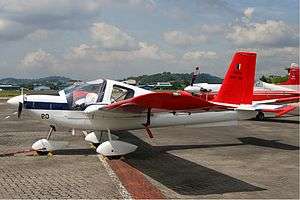SME Aero Tiga
| Aero Tiga, MD-3 Swiss Trainer | |
|---|---|
 | |
| Aero Tiga of the Royal Malaysian Air Force | |
| Role | Trainer |
| Manufacturer | Dätwyler, SME |
| First flight | 12 August 1983[1] |
| Unit cost |
$120,000 for United States model (1993) |
The SME Aero Tiga, originally the Dätwyler MD-3 Swiss Trainer is a trainer aircraft developed in Switzerland through the 1960s and 70s, and which first flew in 1983.
Design and development
In configuration, the Swiss Trainer is a mid-wing, cantilever monoplane with fixed spatted tricycle undercarriage. Accommodation for the pilot and instructor was provided as side-by-side seats under an expansive bubble canopy. The four-cylinder horizontally-opposed piston engine drove a fixed two-blade propeller.
While the layout of the aircraft was entirely orthodox, its construction was not, as the Swiss Trainer was designed to be as modular as possible to lower the cost and complexity of production and maintenance. To this end, as many parts were made interchangeable as possible. For example, all nine control surfaces (two ailerons, four flap segments, two elevators, and the rudder) are the same part that can be fitted to any of these locations with minimal modification. Both halves of the horizontal stabiliser and the fin can similarly be interchanged, and most of the left and right wings is common to both.[1] The aircraft features an unusual exhaust that spans the entire length of the underside of the fuselage. Entry is through a forward sliding canopy that also includes the wing root fairng.[2]
In 1993, all rights to the design were acquired by SME Aviation of Malaysia, who began to produce it as the Aero Tiga shortly thereafter, having received orders for 20 by the Royal Malaysian Air Force. The first two of these were delivered in 1995, and the order was increased to 60 aircraft the following year. SME also received orders for 20 aircraft for the Indonesian government's flight training center at Curug, as part of a deal by the Malaysian government to acquire IPTN CN-235 transports.
Specifications (MD3-160 AeroTiga)
Data from Brassey's World Aircraft & Systems Directory 1999/2000[3]
General characteristics
- Crew: Two, pilot and instructor
- Length: 7.10 m (23 ft 3⅝ in)
- Wingspan: 10.00 m (32 ft 9⅝ in)
- Height: 2.90[4] m (9 ft 7 in)
- Wing area: 15.0 m2 (161.5 ft2)
- Aspect ratio: 6.67:1
- Empty weight: 670 kg (1,477 lb)
- Gross weight: 920 kg (2,028 lb)
- Powerplant: 1 × Lycoming O-320-D2A, 119 kW (160 hp)
Performance
See also
Aircraft of comparable role, configuration and era
References
| Wikimedia Commons has media related to SME Aero Tiga. |
- "Airdata File: Dätwyler MD-3 Swiss Trainer". Air International. Vol. 26 no. 3. March 1984. p. 154.
- "Datwyler approaches certification". Flight. 15 June 1985. p. 36. Retrieved 2008-02-29.
- Hardeman, Terry (8–14 May 1996). "SME to build four-seat MD3". Flight. p. 24. Retrieved 2008-02-29.
- Lambert, Mark (1993). Jane's All The World's Aircraft 1993–94. Coulsdon, UK: Jane's Data Division. ISBN 0-7106-1066-1.
- "Malaysia to built Dätwyler trainer". Flight. 11–17 August 1993. p. 29. Retrieved 2008-02-29.
- Sarsfield, Kate (5–11 November 1997). "SME achieves Malaysian first". Flight. p. 22. Retrieved 2008-02-29.
- "Swiss approve Datwyler trainer". Flight. 17–23 April 1991. p. 23. Retrieved 2008-02-29.
- Taylor, John W. R. (1987). Jane's All the World's Aircraft 1987-88. London: Jane's Yearbooks. p. 227.
- Taylor, Michael J. H. (1989). Jane's Encyclopedia of Aviation. London: Studio Editions. p. 924.
- Taylor, Michael J.H (1999). Brassey's World Aircraft & Systems Directory 1999/2000. London: Brassey's. ISBN 1-85753-245-7.
- "US treaty nears conclusion". Flight. 13–19 December 1995. p. 25. Retrieved 2008-02-29.